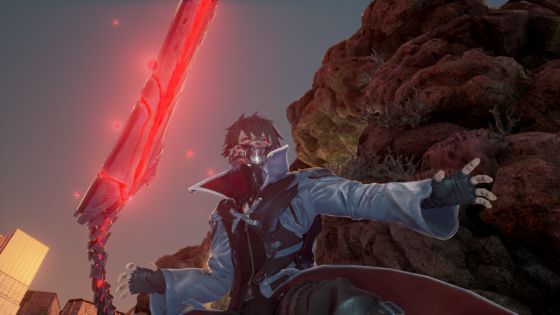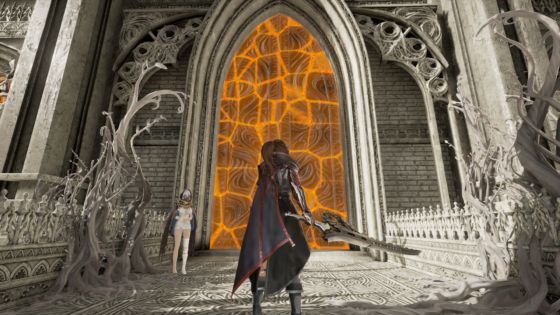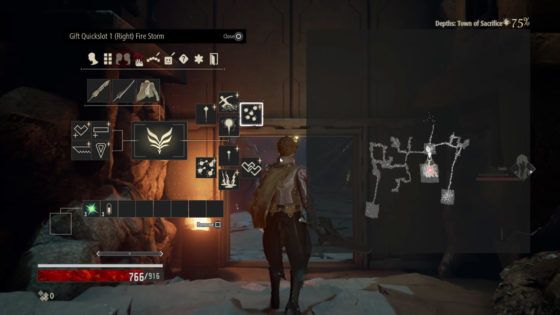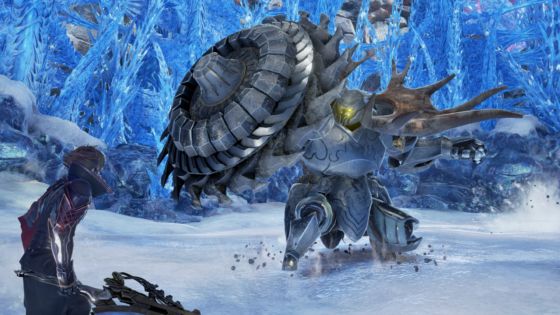As someone whose free time seems to become shorter as the years progress, it’s rare for a game to really stick out to me anymore. It’s even more rare that the hype continues and the game actually lives up to that hype once released. Code Vein is one of those rare gems.
My first introduction to Code Vein came during its E3 2017 reveal. I immediately fell in love cel-shaded, anime art style. Between the aesthetics and short gameplay clips, it looked like a mix of Tokyo Ghoul and Dark Souls. Further reveals did nothing but confirm this initial impression by showcasing hardcore gameplay typically found in the Souls-like genre and the armor-based sub-weapons that very much resembled quinque from Tokyo Ghoul.
The irony here is that while I was immediately captivated by Code Vein, I didn’t enjoy Dark Souls or any of the games that directly fall within its genre. I never found the spoils worth the effort; players aren’t rewarded with a deep story despite enduring masochistic levels of punishments. In contrast, there are plenty of games with challenging gameplay, interesting narratives, and fun combat, such as God of War and Devil May Cry that I have appreciated.
Then how does Code Vein rate for someone who isn’t quite interested in Dark Souls but still loves a good challenge and anime visuals? So far, it’s the best game I’ve played all year.
Blood Beads for the Blood Gods
It's uncommon that any form of media leaves anything to mystery anymore. Upon starting a new game, we’re typically greeted with a 10-minute cinematic describing the events of the past and how they’ve led up to the present with an overview of your character and mission. That's usually after multiple trailers basically spoil the entire plot. Code Vein doesn’t do this.
Instead, you’re given a brief, albeit oddly placed, tutorial about how your character has a broken Blood Code, which basically means you can use any other character’s class, and then immediately thrown into a broken world with little context. You awake to a girl with fan-service proportions and a post-apocalyptic world.
At this point, we have no idea what happened, but there are skyscrapers and vehicles thrown around like a child's plaything while spikes jut out from nearly every surface. It’s clear that something has gone terribly wrong, but we don’t learn what happened or why until much later.
It’s at this point that you’re forcefully recruited to find objects called Blood Beads. These are tiny capsules that grow from white trees and contain a liquid identical to human blood. This liquid is required for Revenants to stave off frenzy, and the only alternative is actual human blood, which is now in short supply. Without it, they risk turning into horrible monsters called the Lost. However, the parasites that cause humans to become Revenants also grant them eternal life, as long as they can protect their heart, but memories are lost on each death.
The story only gets more complicated, and confusing at times, from here on out. This is partially due to pacing but also because much of the story is locked behind the memories of other characters in the game. In order to see the entire game, players need to collect the hidden memories found in vestiges that are scattered throughout the different areas. Unlocking these memories also grants additional skills for certain classes and can even alter the ending of the game.
While the pacing of the game can be a little slow at times, the large gaps between narrative can make it even more addictive. This issue is intensified by the fact that certain areas took considerably longer to clear, which meant hours between plot advances. By the time I finished the Cathedral maze, I had almost forgotten why I was there, but despite that I still had a lot of fun along the way.
Keeping with the mystery theme, we don't actually find out what's going on, or the antagonist's motives, until the final area. This allowed me to keep forming my own ideas about where the game was headed instead of knowing how it would end half-way through. Even though 2 out of 3 ending were eventually predictable, the ‘true ending’ was completely unexpected.
Gameplay: 10/10
The combat and all of the gameplay mechanics mesh together very well in Code Vein. There are dozens of different weapons, and Blood Veils, that cater to different play styles based on their reach, attack speed, damage, stamina consumption, and additional effects. What’s more is that weapon damage and spell damage are calculated differently depending on the chosen class attributes and Blood Veil (armor).
However, the Blood Veil only influences Gift (magic) damage, and not weapon damage, which greatly opens up weapon and class combinations. The biggest limiting factor is the attribute requirements of weapons and Blood Veils. If you don’t have enough Strength or Willpower, certain items will be off limits, however, this can be somewhat worked around through passive abilities that grant increased attributes.
Therefore, it’s entirely possible to play a completely offensive build with a massive 2-handed sword while also being able to cast powerful spells from afar. This does lead to other drawbacks, though, such as reduced stamina, HP, Ichor (mana), and other defensive stats that doesn’t make this type of build ideal in all situations.
In addition to the various weapons and Blood Veils, the game has dozens of classes with unique skills, passive abilities, and attribute combinations that can be obtained through Blood Codes. Some of these are pure classes, such as the melee-focused Berserker, while others are better suited for hybrid builds such as the balanced Hermes code.
This leads to a variety of ways to play Code Vein, and players aren’t required to stick with one style. I found myself constantly switched between 2-handed swords and gift-focused builds depending on the area or boss. There were many times when a boss would stop my current build in its tracks and I would need to re-evaluate my strategy.
There’s an appropriate amount of weight to each action, whether it’s attacking, using gifts, or rolling out of the way, and this is influenced by how heavy your equipment is and passive abilities. While I normally dislike stamina meters in combat-focused games, it fits well in Code Vein. Weapon damage and stamina consumption are generally connected, which makes the player choose between sustained or burst damage. There are multiple bosses where you only have seconds to get a hit in, so higher damage is preferred, but other situations will punish players if their builds don’t allow for ample stamina to dodge. This can lead to a lot of experimentation instead of having one build that’s good for everything, and I believe that’s something many recent games have lacked.
Innovation: 8/10
Code Vein borrows a lot from other games and genres, but everything is put together so well that it feels like some entirely different. There are clearly elements from Dark Souls, such as the difficulty curve, stamina meter, reviving enemies after saving, and the combined experience and currency that’s lost on death. Despite all that, it doesn’t simply feel like another Dark Souls clone.
There’s also a compelling narrative and complex character customization that delivers a multitude of ways to play that can be changed on the fly. Finally, there are vastly different ending based on your level of completion; Code Vein has a lot of secrets and it rewards you for finding them all.
Multiplayer: 8/10
The number of simultaneous online players for Code Vein is limited to 2, essentially making this a co-op experience. Despite this, I thoroughly enjoyed how the multiplayer aspect is setup. Players need to request help in order to allow others to join them. This can be setup to either allow anyone to join or only your friends (via a password).
What I thought was interesting about this system is that once the visiting player dies, they’re kicked out of the world. Having a friend around can definitely help with some of the more difficult parts of the game, but allowing them to only have one life per request doesn’t trivialize the challenge. The level and regenerations available are also scaled to the host, which prevents high-level players from running through the content.
Graphics / Sound: 10/10
As I said earlier, the aesthetics for Code Vein initially drew me in. That didn’t change from the time I first booted up the game until its culmination. It’s one of the most beautiful games on current generation systems.
Each zone felt unique with exceptional detail in both the areas the player can physically explore and the ominous backgrounds that often sent chills down my spine. This was truly a world in shambles and I was reminded of this at every turn.
There are only two concerns that I had during my experience. The first was the clear disparity between the characters. Most of the main characters are highly detailed with unique faces while others tended to look overly generic. There were also areas where I experienced FPS drops, even though I was playing on a PlayStation 4 Pro. Oddly enough, it was the detailed environment that caused this slowdown and there was never an issue during combat regardless of the number of enemies on screen.
The soundtrack by Go Shiina, known for God Eater and the Tales series, is also something that shouldn’t be overlooked. His dark, orchestral tones really set the ambiance for certain scenes and battles.
Value: 10/10
A quick playthrough will easily take 20 hours while the most dedicated players will put significantly more time into this one unlocking every single memory and playing around with the dozens of class combinations. Once you complete the game, there’s a New Game+ mode, and there’s always the option to play online with friends.
Simply counting the hours isn’t enough to weigh in on the value, though. I enjoyed every minute of my time with Code Vein, and that’s where they real value comes in.
Overall: 9.5/10
Code Vein isn’t the anime Dark Souls that many people were expecting, and I’m all the more happy for it. Instead, we get something that borrows from the Souls-like genre but still ends up being its own unique beast. There’s nothing quite like Code Vein on the market, and few games are as satisfying from beginning to end.
Pros:
Nearly incomparable levels of customization
A dark, beautiful world and soundtrack
Highly complex story that weaves together multiple character stories
Combat that rewards both skill and strategy
Cons:
Fan service can be off putting.
Decreased performance in certain areas



